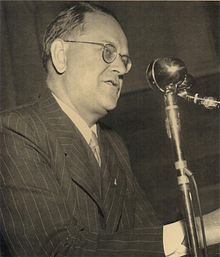Tage Erlander | |
|---|---|
 | |
| 25th Prime Minister of Sweden | |
| In office 11 October 1946 – 14 October 1969 (23 years, 3 days) | |
| Monarchs | Gustaf V Gustaf VI Adolf |
| Preceded by | Östen Undén (acting) |
| Succeeded by | Olof Palme |
| Personal details | |
| Born | 13 June 1901 Ransäter, Värmland County, Sweden |
| Died | 21 June 1985 (aged 84) Huddinge, Stockholm County, Sweden |
| Political party | Social Democrat |
| Spouse | Aina Erlander |
| Alma mater | Lund University |
| Signature | |
ⓘ (13 June 1901 – 21 June 1985) was a Swedish politician who served as Prime Minister of Sweden from 1946 to 1969. He was the leader of the Swedish Social Democratic Party and his uninterrupted tenure of 23 years as head of government is a record for parliamentary democracies,[citation needed] with the popular expression "Sweden's longest Prime Minister" referring to both his physical stature and tenure (the Swedish word lång meaning both long and tall).[1]
Ascending to the World War II coalition government in 1944, Erlander rose unexpectedly to leadership upon the death of Prime Minister Per Albin Hansson in October 1946, cementing the position of the Social Democratic Party as the virtual government of Sweden. Known for his moderation, pragmatism and self-irony, Erlander constantly sought approval from the liberal-conservative opposition for his policies, de facto dropping all pretences of wide-scale nationalizations whilst introducing reforms such as universal health insurance, pension additions and a growing public sector while stopping short of raising tax levels above the average OECD levels at the time. Until the 1960s, income taxes were lower in Sweden than in the United States.[2] Despite a general lack of majority, Erlander's domination of Swedish politics was near-complete. In 1951-1957, he espoused a coalition government with Peasants' League chairman Gunnar Hedlund in order to secure majority and stability, led by himself.[3][4]
Under Erlander, the central pillars of the Swedish welfare state were enacted between 1946 and 1947, a period known as the Social Democratic “Harvest Time.” In1 946 and 1947, three major reforms were enacted that introduced a basic pension, general child allowances and sickness cash benefits. The National Housing Board was set up as the central authority providing subsidized loans and rent controls, while the National Labour Market Board was established to coordinate the nationalized local employment offices and supervise the union-controlled but state-subsidized unemployment insurance funds. In 1947, a tax reform was carried out in 1947 that reduced income taxes in low-income brackets, introduced an inheritance tax, and raised the marginal tax rate for higher tax brackets.[5]
In 1948, a general child allowance was made payable to all persons in Sweden with at least one child under the age of 16. In 1947, housing allowances for families with children were introduced. In 1954, housing allowances were introduced for pensioners. In 1960, the income-test for the children’s pension was abolished. In 1950,a ten-year experimental period was established to build up a nine-year compulsory comprehensive school to replace the old parallel system. A law of 1955 provided state subsidies for municipally organized vocational schools, while a law of 1958 provided state subsidies for folk high schools. In 1962, a final decision was made on nine-year comprehensive school; implemented over a ten-year period. A law of 1964 revised upper secondary school; introduced special preparatory vocational school (fackskola) to complement the high school (gymnasium). A law of 1964 expanded higher education; new decentralized universities and colleges. A law of 1967 instituted municipal adult education (vuxenutbildning).[6]
In foreign policy, he initially sought an alliance of Nordic countries, but without success, instead maintaining strict neutrality while building up among the most impressive armed forces in the world (surpassed only by the United States, the Soviet Union and Israel in terms of per-capita spending), making the Swedish Air Force the third largest in the world, while ultimately rejecting nuclear capability, signing the nuclear non-proliferation treaty in 1968. Erlander's mandate coincided with the post-World War II economic expansion, in Sweden known as the record years, in which Sweden saw its economy grow to one of the ten strongest in the world, and subsequently joined of the G10.
Resigning after the Swedish general election, 1968, his seventh and most successful election in which the Social Democrats surpassed all four opposition parties in terms of seats, Erlander was succeeded, in the midst of constitutional reforms, by his long-time protégé and friend Olof Palme. Dying on June 21, 1985 at age 84, Erlander's funeral procession crossed the country from Stockholm to his home town of Ransäter in triumph for his final interment.
